Photographing mosques: Asia and Africa
Ask any Catholic and an overwhelming majority have not entered a mosque. For Filipinos in particular, the exposure would be slim as not only is the Philippines predominantly Christian (80%), the some 5% of the population who profess the religion of Islam are concentrated in the southern part of Mindanao.
I probably would not have ventured into a mosque were it not for my frequent travels. As a photo hobbyist, I am fascinated by the architecture and grace of mosques. Motifs feature repetitive and rhythmic patterns, radiating and concentric structures and even Arabic calligraphy. In replacement of the human form common in Christian art but as a rule forbidden in Islam, geometric forms come into play, suggesting the shapes of nature, like leaves and flowers and on occasion animals specifically birds. Architectural attractions closely identified to mosque include domes, vaults, courtyards and minarets.
While mosques are open to any practicing Muslims, some do allow visitors. Most of the photos are exterior shots though as often, time is not on my side when I pass by these mosques. Whatever interior shots I have of the few mosques I have entered, I am sharing them below. Hopefully someday, I will be able to take more.
Masjid Muhammad Cheng Hoo, Surabaya, Indonesia
As there are Chinese churches, there are also Chinese mosques. Sino-Islamic architecture are distinct from traditional dome and minaret design. Think of pagodas and Chinese scroll paintings.
One gorgeous example is the Masjid Muhammad Cheng Hoo in Surabaya. Established to commemorate the arrival of Chinese Muslims who sailed from Mainland China to Java several centuries ago, the mosque has to be seen to be appreciated. 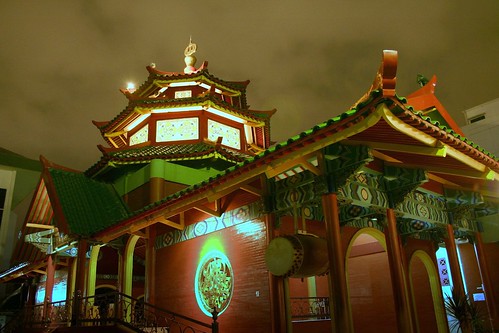
Canon EOS 350D Digital, 1.3s, f/4.5, 18mm, ISO 400
Masjid Muhammad Cheng Hoo, Surabaya, East Java, Indonesia
phototip: night exposures are dramatic… be careful of bleeding.
When I visited the mosque last year, it was during nighttime. Fortunately, the watchmen still allowed us in and here is a glimpse of geometrically sharp interiors.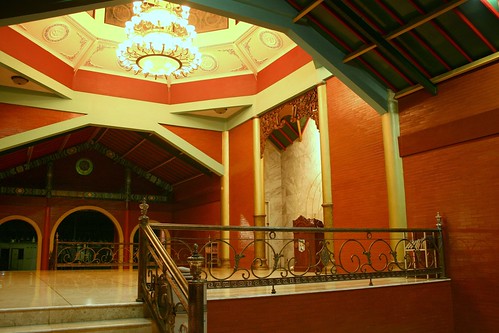
Canon EOS 350D Digital, 0.5s, f/4.5, 18mm, ISO 400
Masjid Muhammad Cheng Hoo, Surabaya, East Java, Indonesia
Masjid Abdul Gaffoor, Singapore
From the outside, one thing is clear with the Masjid Abdul Gaffoor. This mosque has walls and minarets embellished with a plethora of celestial bodies. Crescents shot up profusely from the minarets around the central dome. 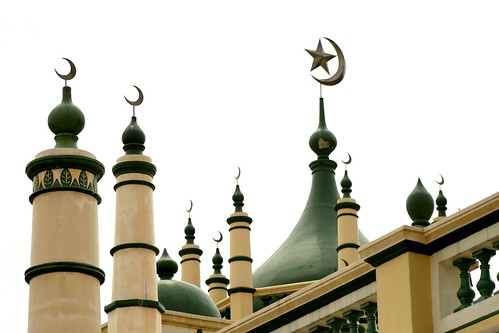
Canon EOS 350D Digital, 1/1000s, f/4.5, 110mm, ISO 100, +1.0EV
Masjid Abdul Gaffoor, Little India, Singapore
phototip: Focus on the extraordinary, that which makes the architecture unique. In the case of this mosque, it is the profusion of crescents adorning the roofline. Getting them in one shot is difficult. I had to overexpose the shot by 3 stops (a full 1 EV) to provide the contrast and drown the noon sky a bright white.
the Sultan Mosque, Singapore
Back in August 2006, I was having a wonderful dinner meet with Singapore flickr friends in a place called Zam Zam at Arab St. The Muslim restaurant just happened to be across the Sultan Mosque so we had plenty of time to shoot the mosque after sundown. Some mosques, I think, are perfect for night photography. Such is the case of the Sultan Mosque with its beautiful golden dome. 
Canon EOS 350D Digital, 20s, f/18, 18mm, ISO 100, -1/3EV
Sultan Mosque, Arab St, Singapore
Masjif Nurul Huda, Bali, Indonesia
This is mosque is probably an early 20th century structure right in the heart of Klungkung regency. We stopped over this mosque one afternoon to take a toilet break. Mosque toilets are open to everybody and are known to have clean running water. This one takes the cake: every one of the 12-15 cubicles in the men's and women's rooms have 2 taps of fully running water that just stream down the drain! I hope they get their source from a river somewhere or else that's a wasteful use of a resource.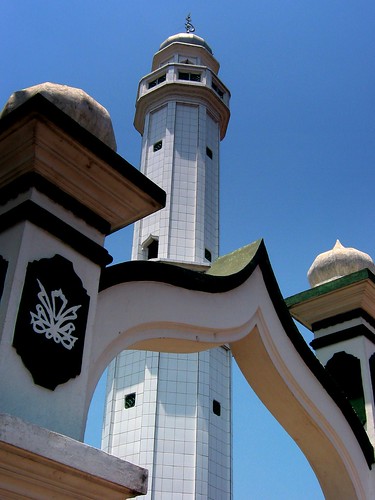
Canon PowerShot S40, 1/400s, f/8.0, 8.6mm
Masjif Nurul Huda, Klungkung, Bali, Indonesia
Masjid Raya, Makassar, South Sulawesi, Indonesia
This is a fairly new mosque that was made by the initiative and benefaction of the current vice president of Indonesia. Reputed to be the richest man of the country who made his fortune in holdings from real estate to forestry, Hj Jusuf Kalla made sure that this mosque stands out in lime and soft yellow. The exterior and interior furnishings are said to have come from Turkey.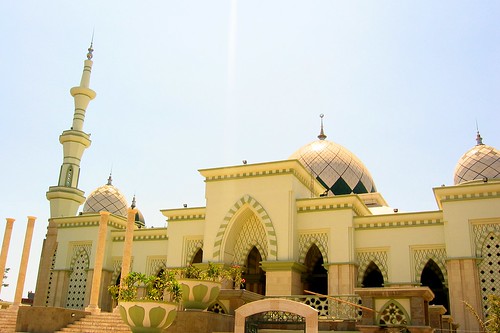
Canon PowerShot S40, 1/500s, f5, 7.1mm
Masjid Raya, Makassar, South Sulawesi, Indonesia
phototip: Use noontime sun to make the marble gleam.
Masjid al Markaz, Maros, South Sulawesi, Indonesia
Indonesians love to express their faith by building mosques. This one in Maros, a town south of Makassar, was just a skelelon last June 2005 but when I took the photo in October of the same year, it looked almost finished. In primary yellow and red, the architecture is stunning. The tiles are said to have come from Australia.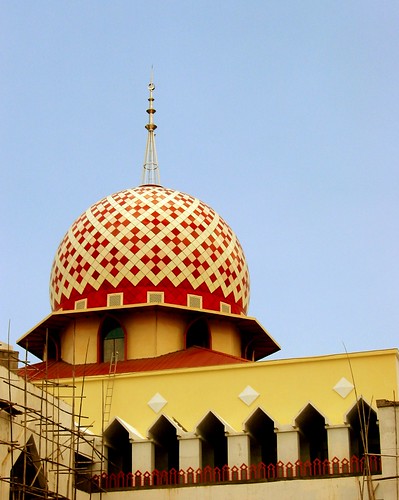
Canon PowerShot S40, 1/800s, f5, 14.7mm
Masjid al Markaz, Maros, South Sulawesi, Indonesia
Masjid Agung Surabaya, Surabaya, Indonesia
This is a truly eye-catching mosque by the ~10km Gresik-Surabaya toll highway connecting Surabaya and the Juanda Airport. Its construction started around 1993 but was finished in about 8 years. It is so big and so blue. The mosaic, the tiles and the minaret are visually arresting.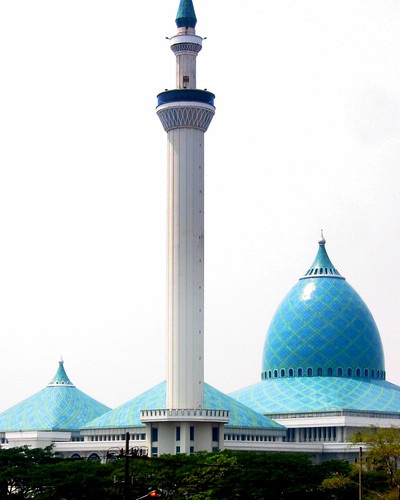
Canon EOS 350D Digital, 1/125s, f8.0, 17.5mm
Masjid Agung Surabaya, Surabaya, Indonesia
phototip: If possible, do not crop minarets! Unfortunately, I was traveling in a speeding car when I took this.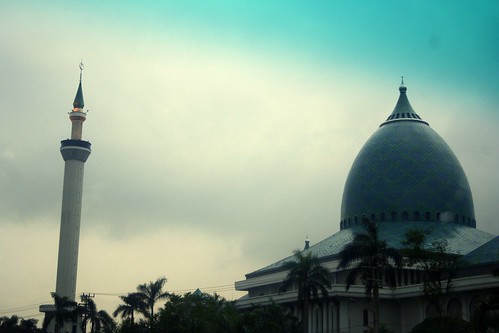
Canon EOS 350D Digital, 1/125s, f/5.0, 37mm, ISO 400, +1/3EV
Masjid Agung Surabaya, Surabaya, Indonesia
the Mosque du Nord of Diego Suarez, Madagascar, East Africa
In Madagascar, about half of the population are Christians who are concentrated in the central highlands and half are Muslim who are mostly in the coast. You therefore see a lot of small quaint mosques in the northeast city of Diego Suarez. The Mosque du Nord in beach of Ramena in the Emerald Bay is particularly small. Not only is it built on the sand, it sits on such a parched and arid landscape which could only be described as unforgiving.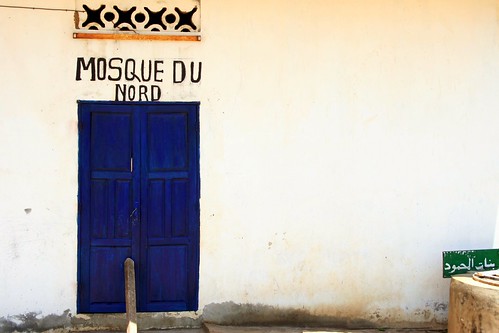
Canon EOS 350D Digital, 1/80s, f/10, 40mm, ISO 100
the Mosque du Nord, Ramena Beach, Diego Suarez (Antsiranana), NE Madagascar 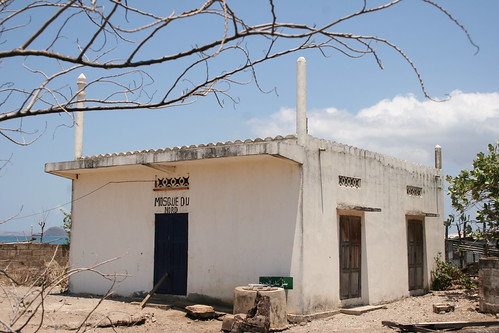
Canon EOS 350D Digital, 1/250s, f/10, 30mm, ISO 100
the Mosque du Nord, Ramena Beach, Diego Suarez (Antsiranana), NE Madagascar






4 comments:
Yes, the verticals are not straight. Look to that, makes your photos look fall over.
Such brilliant shots daeserve better.
I like what I learn about mosques.
Have a great weekend
Gina from Germany
Gina- Thanks for the comments
There's a term for "bent" verticals- angular distorition. They are a result of taking photos at wide angle and is a photographic device by choice and not by accident.
You are a very good photographer.
Loved the ariel shots.
priscilla- thanks for the compliments
Post a Comment